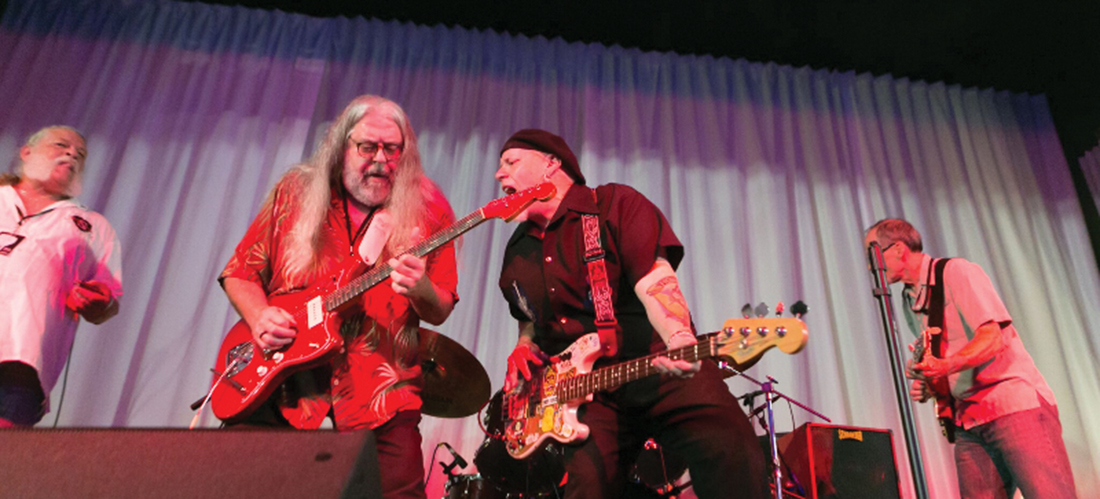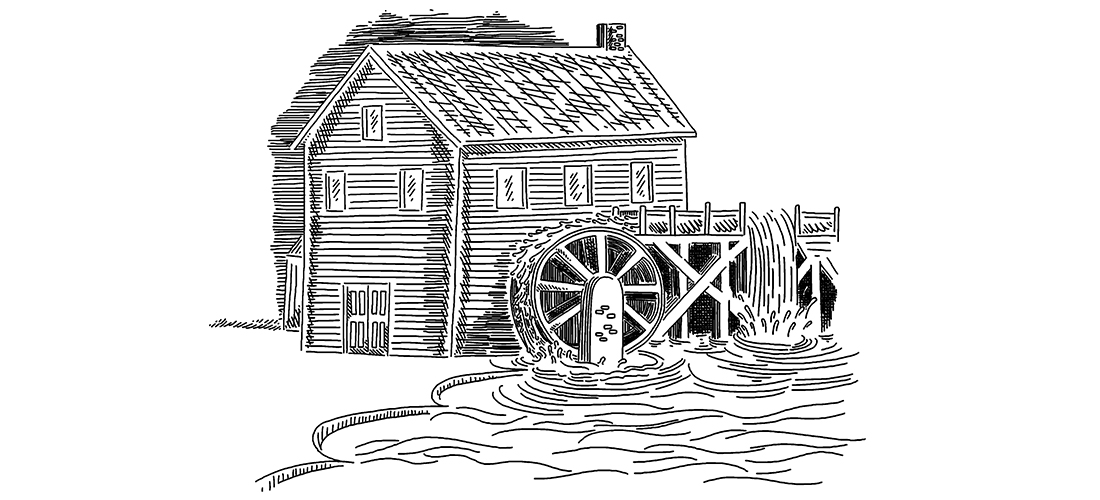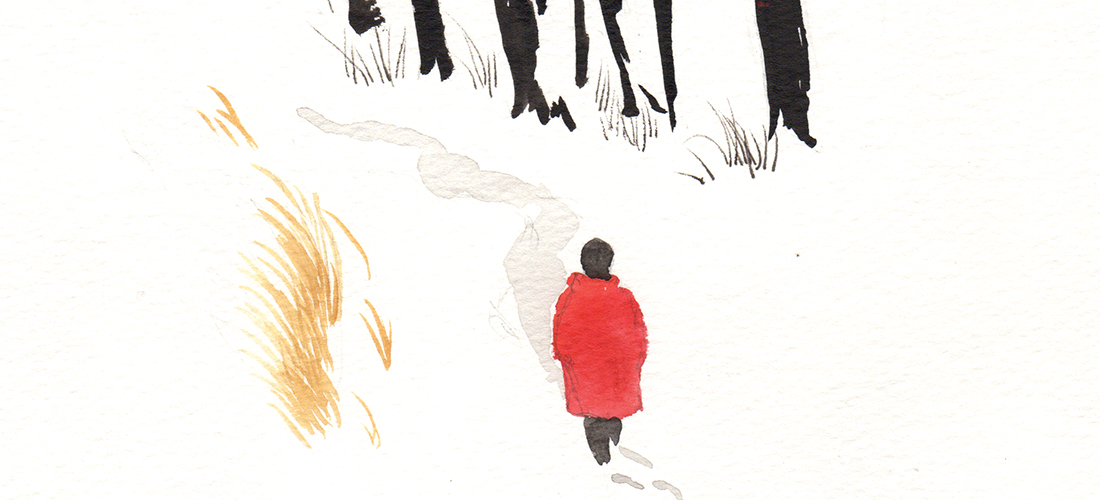The Path Home
Finding roots among the brambles
By Jim Dodson
Not long after dawn on New Year’s Day, my wife, Wendy, and I picked our way through a patch of misty briar-choked woods to the base of an Interstate bridge that spans the Haw River in Alamance County.
One hundred fifty years ago, my father’s great-grandfather operated a gristmill on the banks of the Haw, one of the state’s most important rivers. His name was George Washington Tate. As a kid, I’d seen the remains of the long-abandoned mill sitting at the river’s edge below the railings of the bridge, overgrown with weeds but clearly visible.
Half a century later, I was curious to see if the ruins of the mill might still be there.
George Washington Tate was something of gentrified Jack-of-all-trades — accomplished land surveyor, cabinetmaker, gristmill owner and prominent figure in the affairs of his church and economic development of neighboring Alamance and Orange counties. I grew up hearing that he was the man who officially established the legal boundaries of the state’s central counties following the Civil War. Greensboro’s Tate Street, which borders the campus of UNCG, is reportedly named for him.
Bits of family lore hold that old GWT was a circuit-riding deacon or lay minister who helped establish several Methodist churches across the western Piedmont, another that he forged the original bell in the Hillsborough courthouse.
The tale that has long fascinated me, however — first told to me by a pair of elderly spinster great-aunts named Josie and Ida, who lived into their 90s on Buckhorn Road east of Mebane — was that my father’s grandmother (Tate’s youngest daughter, Emma) was actually an orphaned Cherokee infant Tate “adopted” and brought home from a circuit ride out West, adding to a family that already included three sons and three daughters.
My dad soon confirmed this. As a kid, he’d spent many of his happiest summers as a kid staying with Aunt Emma at her farm off Buckhorn Road near Dodson’s Corners, and often talked about his grandmother’s closeness to the land and keen knowledge of natural medicines made from native plants he had sometimes helped her gather. “To a lot of her friends and neighbors, Aunt Emma was the community’s healer,” he explained to my older brother and me one Christmastime when we went to shoot mistletoe out of the huge red oaks that grew around her abandoned home place. “In those days the only doctor around was over in Hillsborough, 20 miles away.” He added, almost as a wistful afterthought: “She was happiest out in the woods and fields and knew the names of every plant. Local people loved and depended on her.”
Aunt Emma died in 1928, when my father was just 13. Aunt Emma was 70.
“She was an old lady,” he told me many years later, “but her death was shocking — the way she died. For years it was our family’s darkest secret, the thing nobody spoke about. No one saw it coming.”
Aunt Emma reportedly hanged herself from a beam of the house she shared with her husband, Jimmy. Years later, my father’s take on this was that she was challenged living with a foot in two worlds.
A grieving Uncle Jimmy soon gave up his farm and went to live with relatives in Greensboro, abandoning the family property. He lived another 14 years, passing away in 1942, the year my father enlisted in the Army Air Corps and trained to be a glider pilot for D-Day.
Because I heard this part of the story late in life — during a final trip to Scotland with my dad in 1994, when he was dying of cancer — I became more or less obsessed with Aunt Emma’s mysterious death and the colorful stories I’d grown up hearing about her important papa, George Washington Tate.
To some in our family — those who never heard this part of the story — my father’s grandmother is simply a tiny name on perhaps the largest family tree anyone has ever seen. I own a copy of this massive genealogical document, boasting a thousand or more family names branching off the taproot of one Thomas Squires and wife, Elizabeth, English settlers who arrived in the state in the late 1760s.
Most likely, they were part of the massive migration of Europeans along the so-called Great Wagon Road that brought an estimated half a million Scots, Irish, English and German settlers from Pennsylvania to Virginia and the Carolinas about that time. The Great Wagon Road, which began in Philadelphia and roamed out toward Lancaster and Harrisburg before turning south through Maryland and the valley of Virginia, crossing the Carolinas before terminating at the Savannah River in Augusta, Georgia, at 800 miles, was the most heavily traveled road in Colonial America.
Built over ancient Indian hunting routes, it’s the trading road that populated the South and served to open the Western frontier beyond the mountains. Thomas Jefferson’s daddy surveyed and named it. A young George Washington served as a scout along it, and no less than three wars were contested along it — including several key battles during the French and Indian, American Revolutionary and Civil Wars.
Today, if you ever travel Interstate 81 north of Roanoke, you’re traveling the path of the Great Wagon Road. The original road veered southeast from there and crossed into the Yadkin Valley, bringing the Moravians to Old Salem and the Quakers to Guilford County, before moseying along rivers toward Salisbury and the city named in honor of Queen Charlotte. After that, it split into two routes as it crossed South Carolina until meeting again in Georgia.
Last summer, my dad’s first cousin Roger Dodson, a retired missionary and wise family elder who grew up hearing many of the same stories I did about Aunt Emma, provided me with the only known photograph of the family mystery woman and shared his memories of having Uncle Jimmy live with his family for a time after Emma Dodson’s death. Roger also showed me a magnificent corner cabinet made by George Washington Tate, who operated a carpentry shop at his gristmill on the Haw. The cabinet is a one-piece work of art.
George Washington Tate was laid to rest beside his wife, Rachel, in the cemetery behind the Lebanon United Methodist Church in the country above Mebane.
Aunt Emma rests beside her husband, Jimmy, in the smaller burying ground at Chestnut Ridge Methodist Church, not far from Dodson’s Crossroads in Orange County.
Which brings us back to the edge of the historic Haw River on a cold and misty New Year’s morning a month or so ago.
Almost every American’s ancestors hailed from someplace else. But an old road, as the saying in the country goes, always brings someone home.
At a time when polls show many Americans are thinking anxiously about what direction our frontier democracy may go, I’m planning to spend the next year traveling and researching a book on the Great Wagon Road — the road that brought my people, and quite possibly yours, to this part of North Carolina.
It’s a book I’ve been keen to research and write for over a decade and a quest to try to find old George Washington Tate’s lost gristmill seemed like the ideal way to begin such a journey.
Unfortunately, time and progress stand still for no man. And part of me feared that the site where I first laid eyes on the foundation of my ancestor’s mill in the late 1960s — a popular river ford dating from the earliest days of the colony — had most likely been subsumed beneath an interstate highway that has doubled in size since I last visited.
As we stood on the banks of the river, we saw old trees and a handful of boulders in the slowly swirling eddies but, alas, no trace of the mill’s foundation.
I decided to take a couple of photos just the same, as my wife wandered over to a thick patch of brambles and pushed through to a small wooden maintenance bridge that crosses a gully to the base of the bridge.
“Oh, my gosh,” she said moments later, quietly adding, “Come here and look.”
Below the bridge was the old millrace, the sluice that once turned the wooden water wheel, half hidden beneath a curtain of old vines. The race was deep and still running with water, and we knew it belonged to the mill because foundation stones were also visible where time and water had exposed them.
As an expert I’ve been talking to about America’s “lost” roads once said to me, our past lies right before our eyes if we only know what we’re looking at — and where.
For this son of the ancient Haw, Aunt Emma and old George Washington Tate, this moment was like finding the start of a long path home.
We took a picture and went to find a robust country breakfast to celebrate our discovery, the start of a promising new year. OH
If your family came down the Great Wagon Road, Editor Jim Dodson would be pleased to hear about it. Contact him at jim@thepilot.com.








